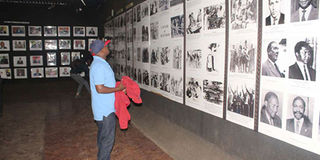Breaking News: At least 10 feared to have drowned in Makueni river
National Archives: from bank to a haven of knowledge

A visitor views photos recording Kenya's history, at Kenya National Archives on May 29, 2019. PHOTO | LUCY WANJIRU | NATION MEDIA GROUP
What you need to know:
- In 1965, the government of Kenya acquired the building and established the Kenya National Archives and Documentation Service to preserve records by Kenyans, about Kenyans.
- By offering internships, attachments and volunteer opportunities to youth, the Archives continues to play a critical role in the lives of Kenyans.
Located in Nairobi’s central business district on Moi Avenue, the Kenya National Archives, a sturdy-looking building, has been around for 88 years.
Construction of Archives, as it is popularly known, began in 1928.
It was commissioned by the National Bank of India, and replaced an iron sheet structure that housed Indian labourers who built the Kenya Railway. It was completed in 1931.
Besides the National Bank of India, the building once housed Kenya Commercial Bank (KCB), which explains the nearby populous bus stage referred to as “Commercial.”
In 1965, the government of Kenya acquired the building. In the same year, by an act of parliament, Kenya National Archives and Documentation Service was established, its mandate to preserve records by Kenyans, about Kenyans.
HISTORY
With records dating as far back as the pre-colonial era and newspaper copies from 1901, the Kenya National Archives is an invaluable resource to Kenyans.
Being in the building is like travelling back in time. Its gallery has been expertly assorted to showcase the transitions Kenyan communities have made from pre-colonialism to date.
Additionally, it houses Murumbi African Heritage Collections of rare books, some of which have gone out of print.
With its vast library, government records from all ministries are preserved here and are available to Kenyans.
To researchers, Archives has been a primary source of information. By offering internships, attachments and volunteer opportunities to youth, the Archives continues to play a critical role in the lives of Kenyans.
Oh! Did you know you only need Sh50 to learn the invaluable history that this magnificent building holds?





